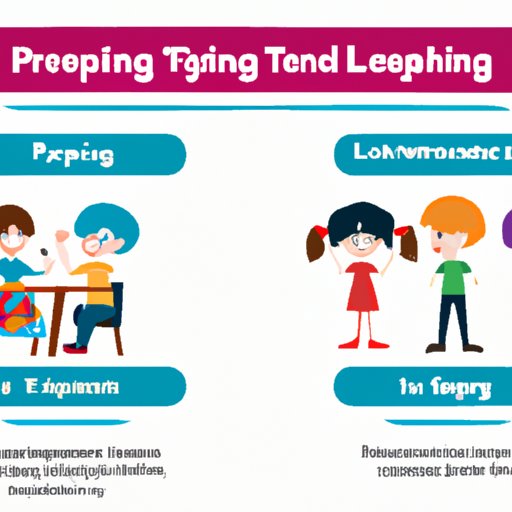
Introduction
Have you ever struggled to comprehend a lesson in class or found it difficult to retain information from a textbook? If so, don’t worry – you’re not alone. Each individual has a unique way of processing information and acquiring knowledge, which is why understanding your learning style is crucial for academic success. In this article, we’ll explore the concept of learning styles, how to identify your own, and how to leverage that knowledge to better academic outcomes.
Discovering Your Learning Style: A Guide To Understanding How You Learn Best
Learning style refers to the way in which an individual processes and comprehends information. It consists of three main components: sensory preference, processing preference, and personality preference. Sensory preference refers to the preferred sensory modality for learning, processing preference refers to the preferred way of processing information, and personality preference refers to the preferred learning environment.
There are seven common learning styles:
- Visual (spatial): prefer to learn through images, charts, and diagrams.
- Auditory (aural): learn best through verbal instruction and listening.
- Linguistic (verbal): learn effectively through writing, reading, and speaking.
- Kinesthetic (physical): prefer hands-on experience to learn, relying on movement and touch.
- Logical (mathematical): tend to learn from logic, reasoning, and problem-solving tasks.
- Social (interpersonal): learn well through group and collaborative activities.
- Solitary (intrapersonal): prefer to work and learn independently.
If you’re not sure what your learning style is, try out some self-assessment tools and tips to identify it. Observe how you tend to study, take note of which types of activities you are drawn to, as well as how you prefer to communicate and express yourself.
Why Knowing Your Learning Style Matters: How To Leverage It For Better Academic Outcomes
Knowing your learning style can improve academic achievement by aligning your study habits with the way you learn best. For instance, a visual learner can use mind maps, diagrams, and colorful notes to retain information. On the other hand, a kinesthetic learner can use hands-on activities, experiments, and physical models to comprehend concepts better. Understanding your learning style also increases memory retention and concentration. You won’t waste energy trying to process information in a way that doesn’t come naturally. Moreover, adapting to your preferred learning style can also enhance motivation and engagement.
To leverage your learning style for better academic outcomes, try the following strategies:
- Think about how you can incorporate your learning style into your study practice.
- Take notes using methods that suit your preferred learning style.
- Reinforce what you have learned through exercises that engage your learning style.
From Visual to Kinesthetic: A Breakdown of the Different Types of Learning Styles
Each learning style has unique characteristics and preferences. Let’s take a closer look:
- Visual learners tend to prefer learning through images and visual aids.
- Auditory learners prefer instruction to be delivered vocally and migh memorize by reciting information aloud.
- Linguistic learners are best able to learn through reading and writing tasks, often using elaborate language to help process ideas.
- Kinesthetic learners prefer a hands-on approach and may have difficulty sitting still for long periods.
- Logical learners like puzzles, problem-solving, and critical thinking to solve complex problems.
- Social learners desire working in groups with peers and benefit from sharing their ideas.
- Solitary learners prefer learning by themselves and benefit from working in a quiet, focused environment.
Examples of study techniques to cater to each learning style include:
- Visual learners: mind maps, diagrams, flowcharts, and videos.
- Auditory learners: lectures, podcasts, and audiobooks.
- Linguistic learners: flashcards, textbook reading, and note-taking.
- Kinesthetic learners: simulations, hands-on experiments, and field trips.
- Logical learners: puzzles, games, experiments, and case studies.
- Social learners: group discussion, collaboration, and peer-to-peer teaching.
- Solitary learners: meditation, journaling, and taking online courses.
The Impact of Learning Styles on Education: How Teachers Can Cater to Different Types of Learners
Classrooms have students with various learning styles. Teachers can address this by using various teaching methods and materials that are more appealing to the students’ preferred learning style. However, it can be challenging to incorporate all styles into a single lesson plan. Teachers can survey their students to better understand their learning preferences and adjust lessons accordingly. There are several teaching strategies to implement, including differentiated instruction, flexible instruction, and assessments tailored to various learning styles.
Some potential positive outcomes of individualized teaching based on student learning styles include:
- Increased engagement and motivation in students to learn.
- Improved grades due to the alignment of teaching with students’ learning style.
- Higher retention of class material due to custom instruction and engaged learning.
Unpacking the Myths and Realities of Learning Styles: What Science Says About the Concept
As the understanding of learning styles has grown, several controversies and misconceptions have arisen. Despite the popularity of learning style theory, there is little scientific evidence of its effectiveness in improving academic outcomes. The myth of learning styles suggests that students can be labeled as a distinct learning style, yet this is not evidence-based. Science indicates that there are benefits to be gained in utilizing different learning strategies that cater to varying learning styles. However, there is little evidence that this method results in increased academic achievement. Therefore, learning style theory can be a guide but should not be the sole basis for teaching and learning.
Conclusion
Understanding your learning style is crucial for academic success. It involves discovering your sensory preference, processing preference, and personality preference. Learning styles play a critical role in academic achievement. Once you know which style of learning suits you best, you can better align your study habits with it. This article has also discussed the various teaching strategies that teachers can use to cater to students’ different learning styles, as well as briefly exploring the science behind the concept of learning styles. Whether you are a student or teacher, knowledge about learning styles can be an invaluable tool for success.




